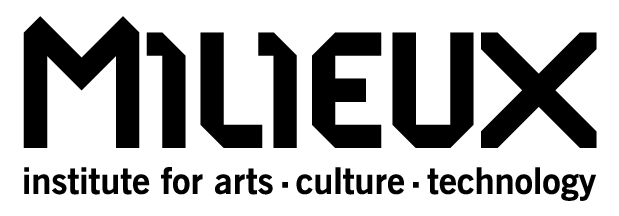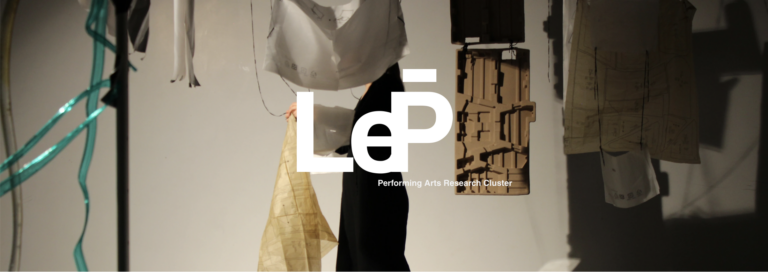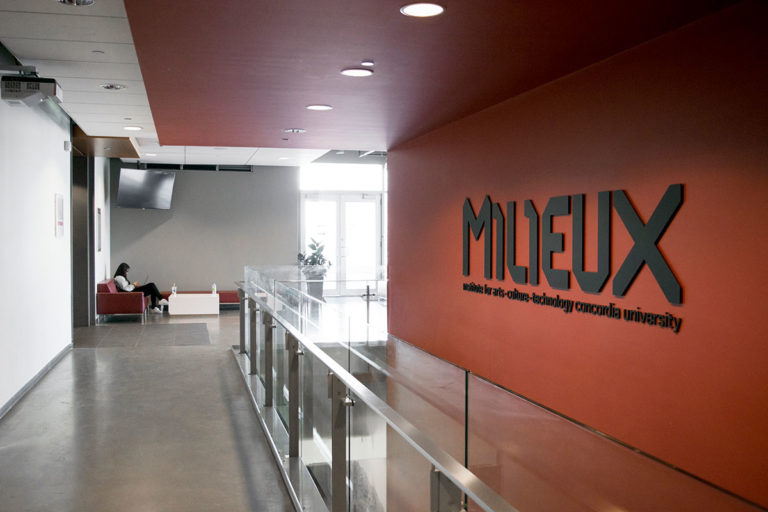Reflection about the Exhibition: November 29 to December 3, 2021
It was an exciting experience to bring my recent artwork together in the solo exhibition Decoding and Reimagining Posthuman Identity. I enjoyed the many steps this entailed, and the deadline this imposed on my completing the bark assemblage.
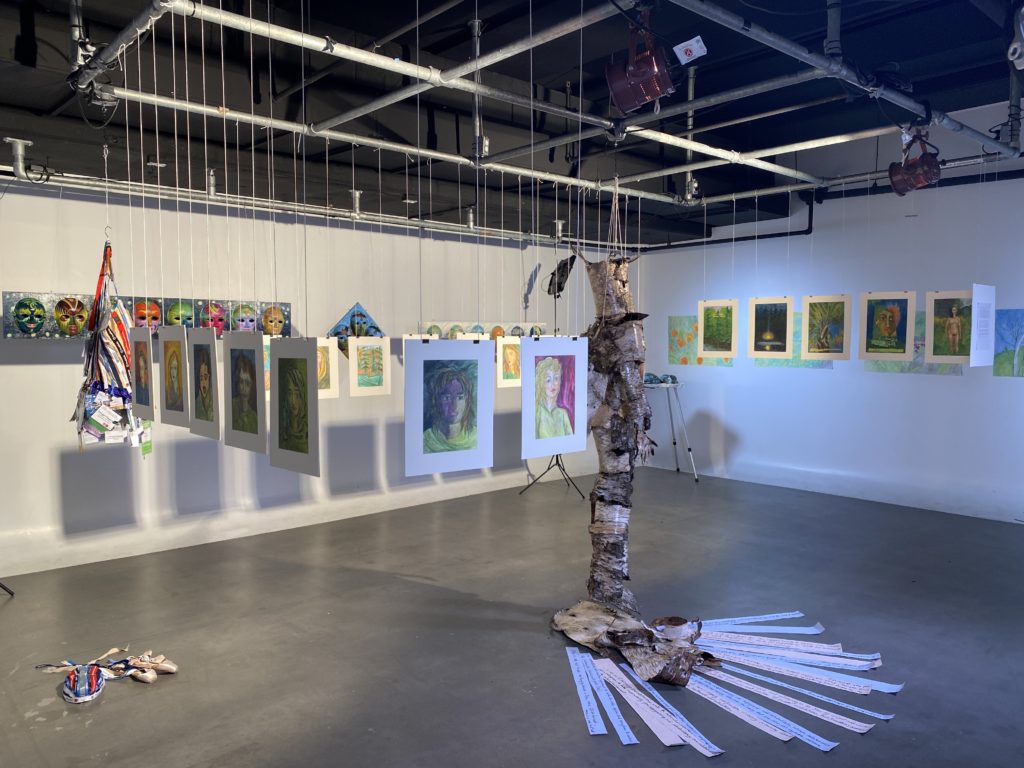
The fact that there were so many works to display added to the time and complexity. I knew where to place the International Law and Governance Conference Lanyard Tutu, and the paper and ceramic masks. As we set up parts of the exhibit and became familiar with the space and the lighting challenges, it became clear that Jeanne B’Arc should be in the centre, with the other works encircling her with her silver bark glinting in the light and the paper strips fanning out beneath her delineating her locus space. I had great help from my partner in arranging the lighting to properly display my works, and to eliminate any obstacles visitors might face navigating the works and the equipment.
Measuring lengths of string and determining how to hang the COVID-19 Faces and the Reflections on the UN Charter was difficult, but once it was complete, it was really gratifying to hear from a visitor that my original idea of having the COVID-19 Faces arranged like a nautilus shell had strangely worked out in this rectangular space. A few people dropped in on the first day and caught us in the messy glory of setup, including gingerly raising and suspending Jeanne B’Arc and attaching her wings/cape, hands and feet; it was wonderful to have the moral support!
Once setup was complete, I enjoyed coming to the space every day, checking to see what had come loose or fallen, and going through the morning ritual of dragging the step ladder from light array to light array, from spotlight to spinning mechanism, until the whole show was lit and spinning, and repeating this ritual in reverse at the day’s end and returning all objects to stasis, all light to darkness. I received a handful of visitors each day, which allowed me the opportunity for deep and focused conversations with them. Later in the week, I took out the RISE masks and started playing with them; this persuaded me to put them on display too, so I repurposed the third projector stand for this, rearranging the writing table for participants. While gallery sitting the exhibition, I found it impossible to do anything but experience it. I gave virtual tours of the show on Facetime to my son, my sisters and a great aunt living in France. On the final day of the show, I received a steady stream of small visiting groups, and responded to their questions and comments.
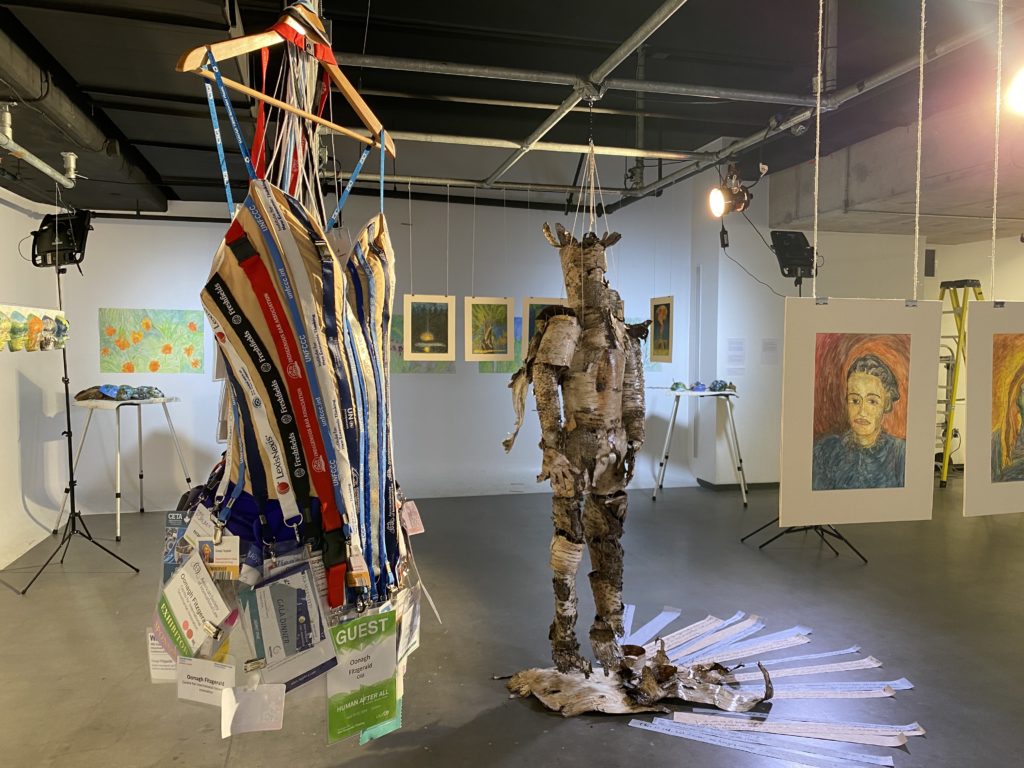
Identity includes understanding our connections to recent and ancient ancestors, landscapes and terrains. We are all the products of natural abundance and natural disaster, human violence, peace-making and redemption, and this is important information to know and carry within me to give me perspective, tolerance, humility, and hope. As is evident from the exhibition, I am fascinated by the connection of human identity and landscapes.
The two clay mask series, Winter Light (reflecting on a frozen lake, through snowy woods and across snow-drifted fields) and Spring Flood (as winter ebbs, everything is melting, the streams are rushing with spring water), generate a litany of questions, including those about the provenance of the clay (Italy and Indiana, respectively), clay’s meaning as a material, clay’s connection to writing and recording and making of law, the relative impermanence of unfired clay and the relative permanence of laws that are encoded and written down, among others. The two- and three-dimensional interplay between the scenes of nature painted on the sculpted clay faces gave rise to confusion, consternation (how can it possibly be an accurate representation of nature?), recognition, and delight. Unsettling, revealing questions arose about realism, expressivity, and embodiment.
Visitors found the four series of painted paper masks, My Cyborg Me; Dreaming Light Through the Darkness; Birds Above Me; and Imprinted Memory, to be quite intriguing, and asked questions about materials used and their positionings, and considered ideas about identity, being, and meaning in masks. They liked the reflective, inverting, recurring idea of being inside and looking out and being observed and looking inward, about how we embody our experiences and how they are imprinted upon us. Others commented on how they liked how I employed different styles and techniques for the three exhibited painting series.
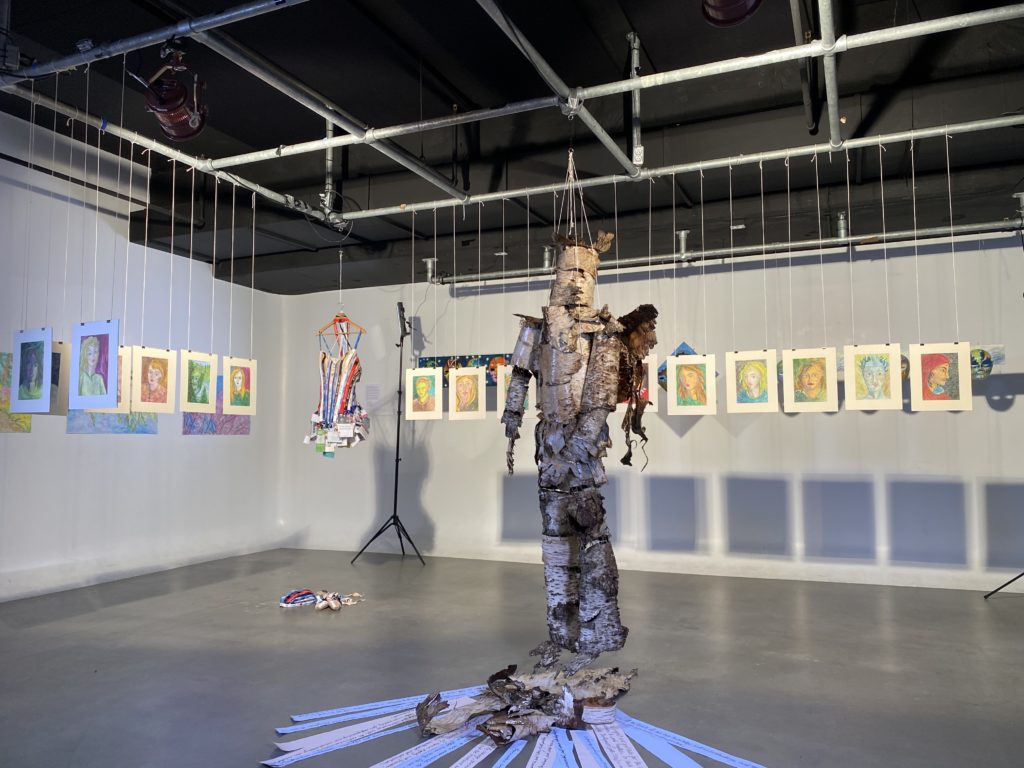
Visitors seemed to enjoy the large watery paintings of the project, Spring Zine-Ing To The Curb And Beyond. Many were pleased to be able to take away a smaller print version folded as a zine for their personal use. With respect to Jeanne B’arc, Posthuman Heroine for The Anthropocene, attendees were intrigued by the birch bark as a material, expressing their own fondness for it. I explained how the assemblage began with one beautiful piece of found bark, how more was accumulated, cleaned, dried, and coated with mod podge, how I tested the wearing of birch bark at the St. Joachim woodland RISE Opera before finishing the assemblage for the show.
There were many conversations about Jeanne B’Arc and her alter ego, Jeanne d’Arc, whether the latter was imaginary or real, mad or visionary, or all of these. One person thought the wooden assemblage was like the pyre on which she was burnt alive. Was the bark assemblage then the ghost of Jeanne, which could explain her decrepitude, aerial suspension and angelic wings? I invited people to write down on the strips of paper their thoughts about Jeanne B’Arc, the woodland values she might represent and the kinds of values we posthumans will need to survive the Anthropocene.
Visitors were intrigued that the assemblage International Law and Governance Conference Lanyard Tutu had taken the form of a tutu without a person inside it. They seemed struck by what I had been able to create with ordinary plastic conference lanyards. Many wondered about the story that might emerge from their own collections of conference detritus.
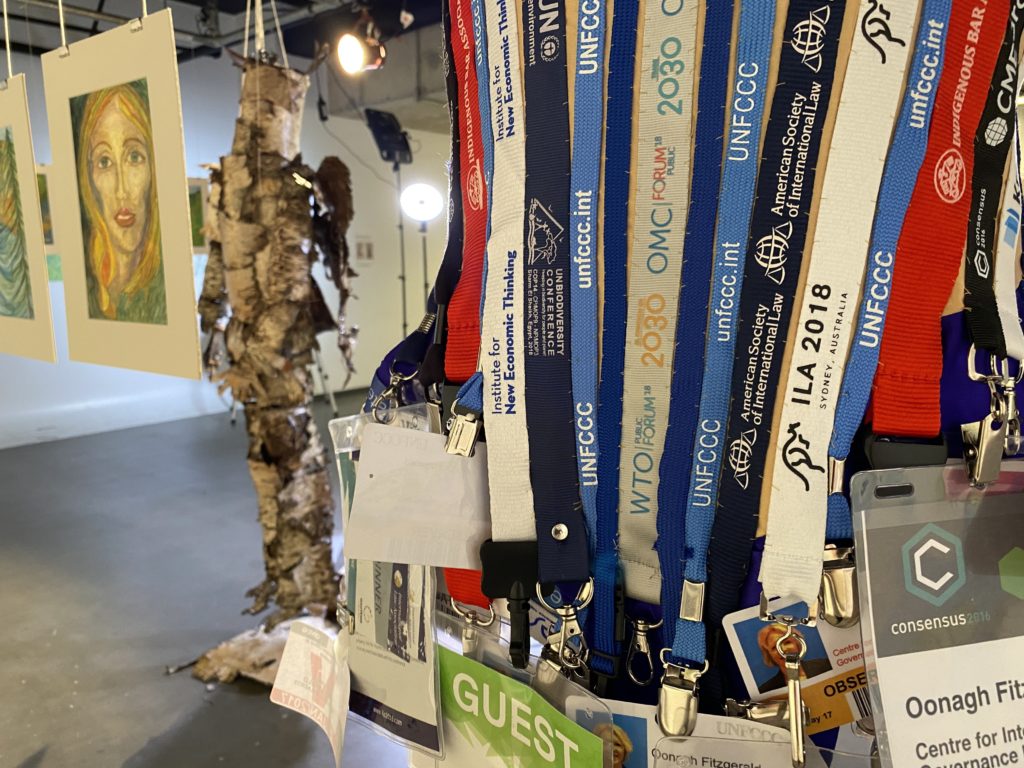
This experience of conversing about art and its context reaffirmed my desire for social engagement with my art. Many commented on how they enjoyed the material, theatrical and environmental elements in all the works. I am realizing that exploration of identity, embodiment and performativity is important to my work and provides rich linkages and reverberations between individual pieces (Auslander, 1997).
Shaviro (2014, p. 156) writes: “hrough aesthetics, we can act in the world and relate to other things in the world without reducing it and them to mere correlates of our own thought. This is why I propose a speculative aesthetics.” According to Barrett (2013, p. 63), “he aesthetic image is “performative”; it emerges through sensory processes and gives rise to multiplicity, ambiguity and indeterminacy.” These ideas suggest that engaging with international law and governance through an artistic and performance practice could produce new insights and envision new futures that likely would be difficult to discover through the discourse of law alone.
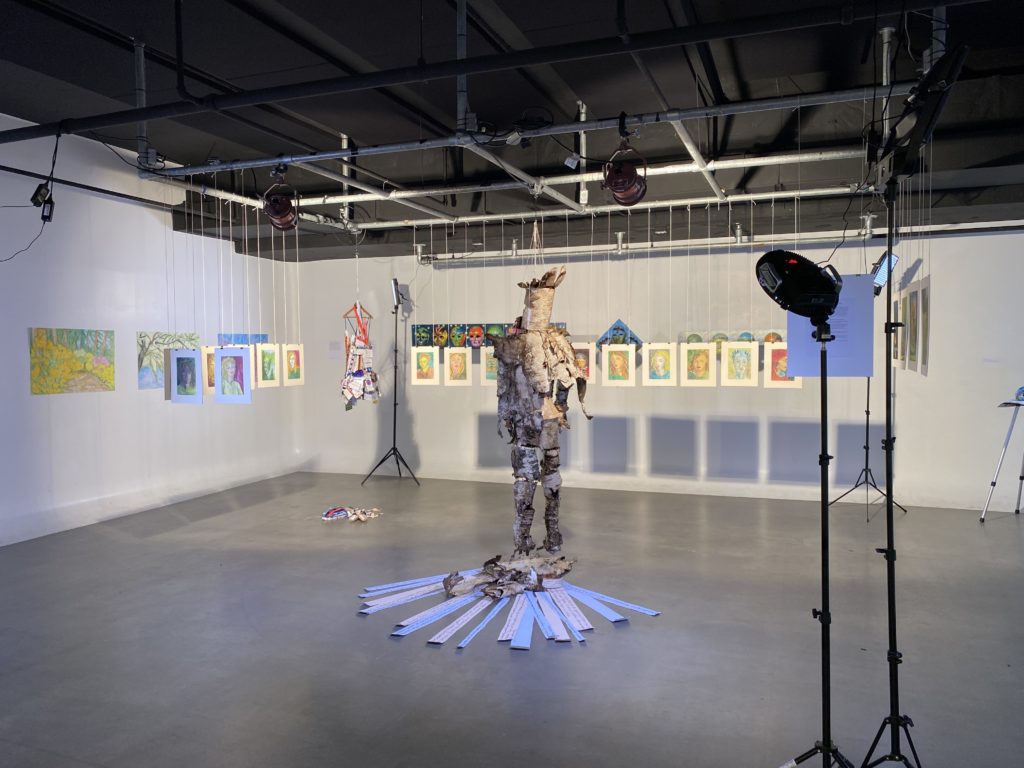
My art exhibition was a performance of sorts – setting it up like a stage lit attractively for visitors to explore and interact with the displayed objects and me, and my presence on the edge of the space, occasionally passing through as custodian and curator. In these roles I also noticed a similarity to when I was promoting the work of my research institute at international conferences, enticing people to our display for conversations and engagement.
The exhibition represented a kind of completion for me, bringing closure to the pandemic months before my admission to the INDI PhD program and the finishing of all my coursework. Through the coursework I was able to advance my art making, social engagement and thinking about decoding/encoding values for a new planetary Charter through each course, making linkages between the learning from each. Having done the LePARC discussion earlier in November and the one-week Milieux exhibition, I can now detach myself somewhat from this body of work and move on to the next stage of my art making and research, building on what I have accomplished so far.
References Auslander, P. (1997). From acting to performance: Essays in modernism and postmodernism. Routledge.
Barrett, E. & Bolt, B. (2013). Carnal knowledge: Towards a ‘new materialism’ through the arts. I.B. Tauris.
Shaviro, S. (2014). The universe of things: On speculative realism, (University of Minnesota Press), Project MUSE. muse.jhu.edu/book/35606. Chapter 7, Aisthesis.
